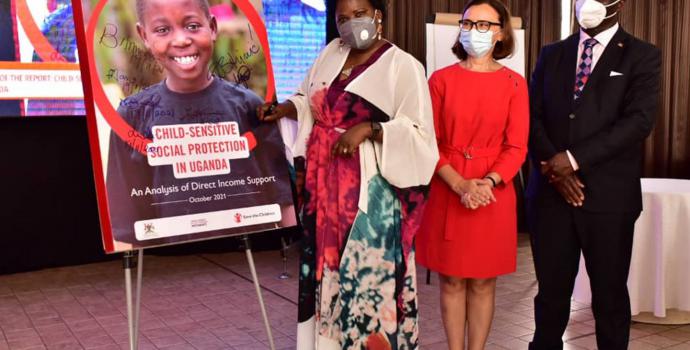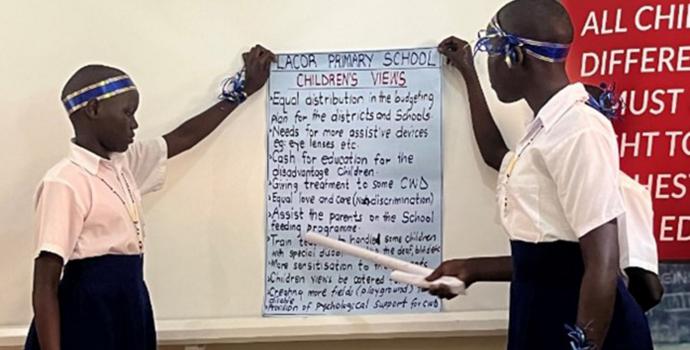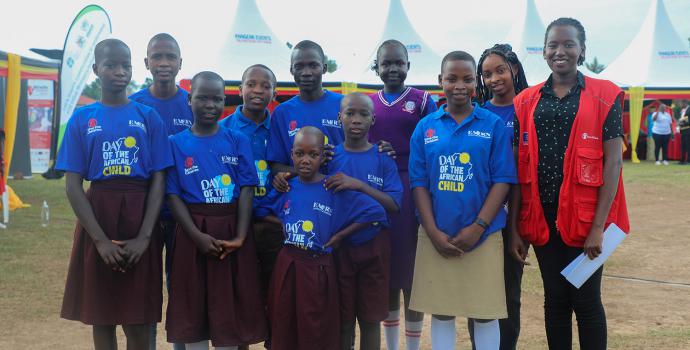Ending child poverty through child-sensitive social protection

Left-Right: Minister of Gender, Labour and Social Development, Betty Amongi, launches the report alongside the Ministry's permanent Secretary, Aggrey Kibenge and SCI-Uganda Country Director Dragana Strinic.
Our vision is a world in which every child attains the right to survival, protection, development, and participation. The sad reality is that many children are denied these rights due to poverty, insecurity, and crises like the COVID-19 pandemic, which widen gaps, creating more inequality. With children unable to protect themselves from these shocks, child sensitive social protection systems are necessary to shield them. For Uganda, where 54% of the population is below the age of 18, such a system is vital.
The “Child-sensitive Social Protection in Uganda: An analysis of Direct Income Support” a report by Save the Children, Development Pathways and Ministry of Gender, Labour and Social Development, launched in Kampala in November, examines the current state of the Ugandan social protection system and its ability to protect children.
Speaking at the launch, Aggrey Kibenge, the permanent secretary Ministry of Gender, Labour and Social Development applauded Save the Children on the report and stated that the government is committed to the cause.
“The government of Uganda, through Ministry of Gender, Labour and Social Development is committed to developing a comprehensive social protection system that is evidence-based. This report is a key milestone in that effort,” he said.
The report found that many children are being raised in families that rely on low income and insecure livelihoods. This means that their income and wellbeing are never assured. Poverty deprives children of the proper nutrition, protection, sanitation, shelter, health care and education they need to survive and thrive. This has lasting effects as the deprivations during childhood ripple into adulthood.
In Uganda, 56% of children live in this kind of multi-dimensional poverty. As a result, many of these children will become adults, who have been unable to reach their full potential, thereby creating a cycle of poverty. These effects are worse among vulnerable groups like children with disabilities, as they need to spend more to access the same resources. These findings show that the overall coverage of children is abysmal, and there is an enormous deficiency of social protection support for children.
Achieving a transformed society

Save the Children country director, Dragana Strinic, speaks during the launch of the report.
As Uganda works to achieve its 2040 vision of being, “a transformed Ugandan Society from a Peasant to a Modern and Prosperous Country within 30 years”, it is crucial that it invests in its children by establishing a child-sensitive social protection programme. And indeed, like Save the Children country director, Dragana Strinic, said,
“In order to strengthen human capital, you need to invest in social protection.” Such a programme would ensure that every child in Uganda can access their basic needs, and address the risks that hinder their development.
Speaking during the launch, Betty Amongi, the Minister of Gender, Labour and Social Development, who was also the guest of honour, said:
“This social protection programme would promote equitable growth, and unlock the full potential of our youthful population.” This would mean that all children would access the same quality of resources, no matter their family’s economic status, removing the effects of economic inequality on a child’s development.
Social protection programmes like Social Assistance Grant for Empowerment (SAGE) and WFP Food distribution are evidence that direct support to lower income families and vulnerable groups reduces inequality and shields them from the effects of poverty. Currently, Uganda invests 0.09% of its GDP in social protection. Increasing this investment can promote economic recovery, ensuring vulnerable children are not left behind as the country recovers from COVID-19. According to Dr. Ibrahim Kasirye, director of research at Economic Policy Research Centre, an investment of only 1% of Uganda's GDP would cover every child, by 2030, under a child grant.
Fortunately, the Government of Uganda has policy proposals and is developing a long-term social protection strategy which draw a road map for a more child sensitive social protection system. As the government makes strides to achieve this milestone, the report recommends a multi-tiered approach of both direct income support and programmes to achieve effective coverage. This will break the vicious cycle of poverty.
The report makes eight recommendations for government
1. As an immediate measure, support all efforts to lower the age of the Senior Citizens Grant to 70. Subsequently, efforts should be supported to lower the eligibility age to 65 years by 2023, which will increase indirect coverage of children from 6 per cent to 11 per cent and expand the benefits for children’s nutrition, schooling and reduction of child labour.
2. Support the successful implementation and evidence building of the two child-sensitive initiatives to inform the incremental growth of a future child benefit: the CSSP in West Nile and the Girls Empowering Girls Social Protection Programme for Adolescent Girls.
3. Integrate measures in LIPW programmes to minimise any unintended harms, such as through flexible work hours for women and provision of childcare arrangements.
4. Monitor the impact of LIPW programmes based on child welfare indicators.
5. As part of the development of the long-term Social Protection Strategy, prioritise implementation of a child disability benefit and make provisions for the gradual implementation of a universal child benefit, building on the experience of the two child-focused initiatives.
6. Based on the provision of minimum direct income support programme, gradually implement a multi-tiered approach to social security – as set out in the draft Vision for Social Security – to strengthen the integration between direct income support and contributory programmes and achieve more effective coverage of the informal workforce.
7. Establish clear targets for a credible government-led financing strategy for social protection, as part of the long-term Social Protection Strategy, that will enable the government of Uganda to realise its lifecycle-based Vision for Social Protection.
8. Invest in strengthening social care and support systems to complement and maximise the impacts of the child-sensitive and child-focused schemes. A long-term strategy to build the capacity of child social services should be developed, identifying key capacity constraints, including financial and human resource needs.




